The Bulldozer Review: AMD FX-8150 Tested
by Anand Lal Shimpi on October 12, 2011 1:27 AM ESTPower Management and Real Turbo Core
Like Llano, Bulldozer incorporates significant clock and power gating throughout its design. Power gating allows individual idle cores to be almost completely powered down, opening up headroom for active cores to be throttled up above and beyond their base operating frequency. Intel's calls this dynamic clock speed adjustment Turbo Boost, while AMD refers to it as Turbo Core.
The Phenom II X6 featured a rudimentary version of Turbo Core without any power gating. As a result, Turbo Core was hardly active in those processors and when it was on, it didn't stay active for very long at all.
Bulldozer's Turbo Core is far more robust. While it still uses Llano's digital estimation method of determining power consumption (e.g. the CPU knows ALU operation x consumes y-watts of power), the results should be far more tangible than what we've seen from any high-end AMD processor in the past.
Turbo Core's granularity hasn't changed with the move to Bulldozer however. If half (or fewer) of the processor cores are active, max turbo is allowed. If any more cores are active, a lower turbo frequency can be selected. Those are the only two frequencies available above the base frequency.
AMD doesn't currently have a Turbo Core monitoring utility so we turned to Core Temp to record CPU frequency while running various workloads to measure the impact of Turbo Core on Bulldozer compared to Phenom II X6 and Sandy Bridge.
First let's pick a heavily threaded workload: our x264 HD benchmark. Each run of our x264 test is composed of two passes: a lightly threaded first pass that analyzes the video, and a heavily threaded second pass that performs the actual encode. Our test runs four times before outputting a result. I measured the frequency of Core 0 over the duration of the test.
Let's start with the Phenom II X6 1100T. By default the 1100T should run at 3.3GHz, but with half or fewer cores enabled it can turbo up to 3.7GHz. If Turbo Core is able to work, I'd expect to see some jumps up to 3.7GHz during the lightly threaded passes of our x264 test:
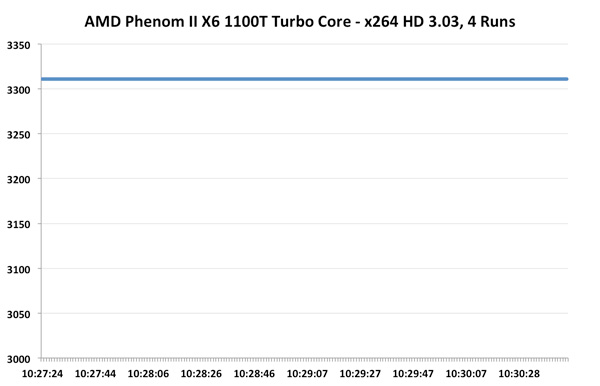
Unfortunately we see nothing of the sort. Turbo Core is pretty much non-functional on the Phenom II X6, at least running this workload. Average clock speed is a meager 3.31GHz, just barely above stock and likely only due to ASUS being aggressive with its clocking.
Now let's look at the FX-8150 with Turbo Core. The base clock here is 3.6GHz, max turbo is 4.2GHz and the intermediate turbo is 3.9GHz:
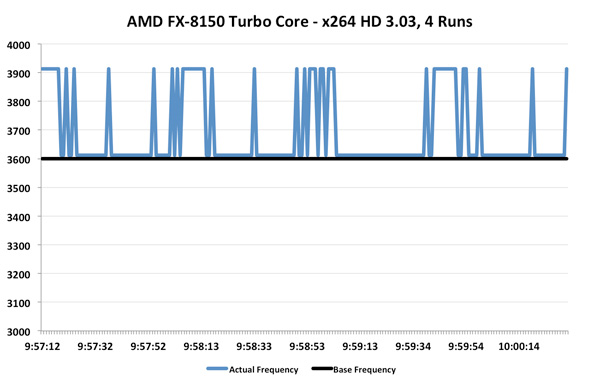
Ah that's more like it. While the average is only 3.69GHz (+2.5% over stock), we're actually seeing some movement here. This workload in particular is hard on any processor as you'll see from Intel's 2500K below:
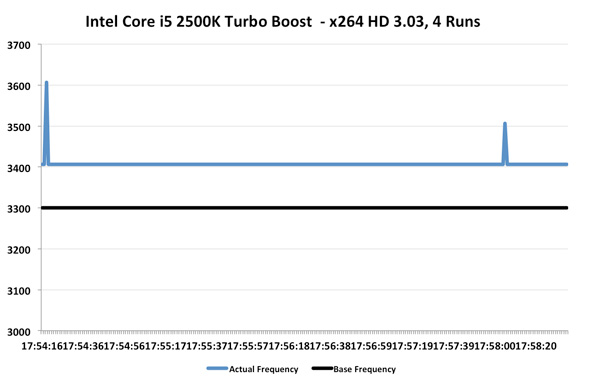
The 2500K runs at 3.3GHz by default, but thanks to turbo it averages 3.41GHz for the duration of this test. We even see a couple of jumps to 3.5 and 3.6GHz. Intel's turbo is a bit more consistent than AMD's, but average clock increase is quite similar at 3%.
Now let's look at the best case scenario for turbo: a heavy single threaded application. A single demanding application, even for a brief period of time, is really where these turbo modes can truly shine. Turbo helps launch applications quicker, make windows appear faster and make an easy time of churning through bursty workloads.
We turn to our usual favorite Cinebench 11.5, as it has an excellent single-threaded benchmark built in. Once again we start with the Phenom II X6 1100T:
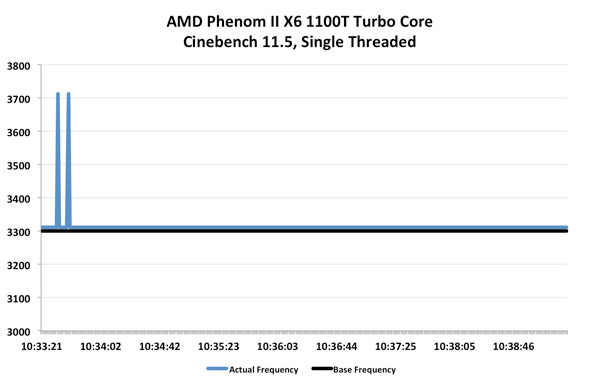
Turbo Core actually works on the Phenom II X6, albeit for a very short duration. We see a couple of blips up to 3.7GHz but the rest of the time the chip remains at 3.3GHz. Average clock speed is once again, 3.31GHz.
Bulldozer does far better:

Here we see blips up to 4.2GHz and pretty consistent performance at 3.9GHz, exactly what you'd expect. Average clock speed is 3.93GHz, a full 9% above the 3.6GHz base clock of the FX-8150.

Intel's turbo fluctuates much more frequently here, moving between 3.4GHz and 3.6GHz as it runs into TDP limits. The average clock speed remains at 3.5GHz, or a 6% increase over the base. For the first time ever, AMD actually does a better job at scaling frequency via turbo than Intel. While I would like to see more granular turbo options, it's clear that Turbo Core is a real feature in Bulldozer and not the half-hearted attempt we got with Phenom II X6. I measured the performance gains due to Turbo Core across a number of our benchmarks:

Average performance increased by just under 5% across our tests. It's nothing earth shattering, but it's a start. Don't forget how unassuming the first implementations of Turbo Boost were on Intel architectures. I do hope with future generations we may see even more significant gains from Turbo Core on Bulldozer derivatives.
Independent Clock Frequencies
When AMD introduced the original Phenom processor it promised more energy efficient execution by being able to clock each core independently. You could have a heavy workload running on Core 0 at 2.6GHz, while Core 3 ran a lighter thread at 1.6GHz. In practice, we felt Phenom's asynchronous clocking was a burden as the CPU/OS scheduler combination would sometimes take too long to ramp up a core to a higher frequency when needed. The result, at least back then, was that you'd get significantly lower performance in these workloads that shuffled threads from one core to the next. The problem was so bad that AMD abandoned asynchronous clocking altogether in Phenom II.
The feature is back in Bulldozer, and this time AMD believes it will be problem free. The first major change is with Windows 7, core parking should keep some threads from haphazardly dancing around all available cores. The second change is that Bulldozer can ramp frequencies up and down much quicker than the original Phenom ever could. Chalk that up to a side benefit of Turbo Core being a major part of the architecture this time around.
Asynchronous clocking in Bulldozer hasn't proven to be a burden in any of our tests thus far, however I'm reluctant to embrace it as an advantage just yet. At least not until we've had some more experience with the feature under our belts.


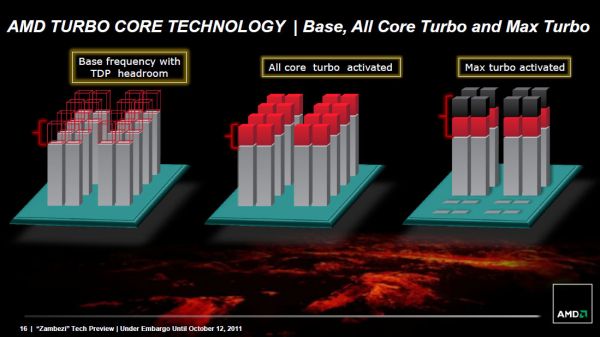








430 Comments
View All Comments
saneblane - Thursday, October 13, 2011 - link
Man, you have a lot of optimism. I am a big Amd fan, but even i can remain optimistic after this mess, I mean how do you make a chip that is slow, expensive and losses to it's older brothers. Barcelona was a huge success compare to this, it only seemed bad because Expectations were high, this time around though they became higher because no one expect Amd to actually go backwards in performance. WOW that's all i can say WOWPipperox - Thursday, October 13, 2011 - link
I don't understand why you all think it's slower than its older brothers.It's not, it's faster than Thuban in practically all benchmarks...
Or do you really care about stuff like SuperPi?
Pipperox - Thursday, October 13, 2011 - link
But maybe you guys think that it's slower "clock for clock" or "core for core".It doesn't matter how you achieve performance.
What matters is the end performance.
Bulldozer architecture allows it to have higher clock speed and more *threads* than Phenom.
The penalty is single threaded performance.
Again you can't compare it to an hypothetical 8 core 4.0GHz Thuban, because they couldn't have made it (and make any money out of it).
I'll repeat, the FX-8150 is NOT an 8-core CPU.
Otherwise the i7-2600K is also an 8-core CPU... both can execute 8 threads in parallel, but each pair of threads shares execution resources.
The main difference is that Sandy Bridge can "join" all the resources of 2 threads to improve the performance of a single thread, while Bulldozer cannot.
They probably didn't do it to reduce HW complexity and allow easier scalability to more threads and higher clock speed.
Because the future (and to a large extent, the present) is heavily multithreaded, and because Bulldozer is targeted mainly at servers. (and the proof is its ridiculous cache)
bryman - Thursday, October 13, 2011 - link
how about some bios screenshots? Is there a way in the bios to disable the northbridge in the chip and use the northbridge on the motherboard? Possibly better performance, or maybe add a new ability to x-fire northbridges? (Yah imah Dreamer). imo, I dont think adding the northbridge to the cpu was a good idea especially if it pulls away from other resources on the chip, I understand what adding the northbridge to the processor does, but does it turn off the northbridge thats already on the motherboard? The northbridge on the chip makes sense for an APU but not for a perfomance CPU, why is the nothbridge even in there. I myself would rather see the northbridge on the motherboard utilizing that space intstead of the space on the cpu.If there isnt a way to turn off the northbridge on the cpu in the bios, i think the motherboard manufactures should include the ability to turn off the northbridge on the cpu. Add the ability to use the onboard northbridge in there bios, so you can atleast get bios or firmware updates to the northbridge and perhaps get more performance out of the cpu/gpu.
When the new Radeon 7000 series video cards come out, if I buy this CPU with the 6000 series northbridge in it, am I going to take a performance hit or am i going to have to buy a new processor with the 7000 series northbridge in it? or will they come out with a 7000 series motherboard that utilizes a 7000 series northbridge that turns off the 6000 series northbridge in the chip, which in turn makes it useless anyways. I myself dont like the fact if i buy this product, if i want to upgrade my northbridge/ motherboard, I might have to buy a new processor/ perhaps a new motherboard or am i just paranoid or not understanding something.
Who knows, maybe in the next couple of weeks, Mcrosoft and/or AMD will come out with a performance driver for the new processors.
If they would have come out with this processor when planned originally, it really would have kicked butt. instead we get conglimerated ideas over the five year period, which looks like the beginning idea, thrown into a 2011 die.
I am i die-hard AMD fanboy and always will be, Just kinda dissappointed, excuse my rants. I will be buying a 4 core when they hit the streets, hopefully in a couple weeks.
saneblane - Thursday, October 13, 2011 - link
From the caching issues, to the bad glofo process, to the windows scheduler, i recon that this processor wasn't ready for prime time. Amd didn't have any choice i mean they almost took an entire year extra for peet sake. Even though my i5 2500 is on it's way, am not stupid enough to believe this is the best the arch can do. Their is a good reason that interlagos cannot be bought in stores, Amd know for a fact that they cannot sell this cpu to server maker, so they are busy working on it, i expect that it might take one or even 2 more stepping to fix this processor, the multithread performance is their so they only need to get a mature 32nm process to crank up the speeds and maintain the power consumptions. IMOarjuna1 - Thursday, October 13, 2011 - link
Reviews @ other sites like toms hardware and guru 3d are starting to make this look bad. How come everyone but Anand got to review it with watercooling?? Is this site in such bad terms with AMD?B3an - Thursday, October 13, 2011 - link
Water cooling isn't magically going to help performance or power consumption in any way so why does it matter?? When you buy this CPU it comes with air cooling, and Anand was right to use that for this review.marcelormt - Thursday, October 13, 2011 - link
http://www.tomshardware.com/reviews/does-amds-athl...Patrick: The 6000+ is the fastest Athlon 64 X2 dual core processor ever, but what happened to the FX family?
Damon: Patrick, you are right. The X2 6000+ is the fastest AMD64 dual-core processor ever... so why isn't it called FX? To answer that I have to explain what FX is all about... pushing the boundaries of desktop PCs. FX-51 did that right out of the gate, with multiple advantages over other AMD processors, and a clear lead on the competition. Move forward a bit to where AMD put high-performance, native dual-core computing into a single socket with the FX-60. Fast forward again and you see FX pushing new boundaries as "4x4" delivers four high-performance cores with a direct-connect, SLI platform that is ready to be upgraded to 8 cores later this year
Ryomitomo - Thursday, October 13, 2011 - link
I'm a little surprised you only posted Win7/Win8 comparison figures for FX-8150. It would give a much complete picture if you would also post i7-2600k Win7/Win8 comparison.czerro - Thursday, October 13, 2011 - link
I think anand handled this review fine. Bulldozer is a little underwhelming, but we still don't know where the platform is going to go from here. Is everyone's memory so short term that they don't remember the rocky SandyBridge start?